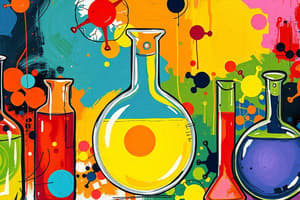Podcast
Questions and Answers
What is the unit of relative atomic mass?
What is the unit of relative atomic mass?
- moles
- kilograms
- grams
- no units (correct)
What is the relative atomic mass of hydrogen?
What is the relative atomic mass of hydrogen?
- 2
- 12
- 1 (correct)
- 6
What is the charge of a neutron?
What is the charge of a neutron?
- 1+
- 2+
- 0 (neutral) (correct)
- 1-
What determines the position of an element on the Periodic Table?
What determines the position of an element on the Periodic Table?
What is the symbol for atomic number?
What is the symbol for atomic number?
What is an element composed of?
What is an element composed of?
What is the total number of elements found in the Periodic Table?
What is the total number of elements found in the Periodic Table?
What is a characteristic of a compound?
What is a characteristic of a compound?
What is the location of the protons and neutrons in an atom?
What is the location of the protons and neutrons in an atom?
What is the function of electrons in an atom?
What is the function of electrons in an atom?
What is the unit used to express the mass of an atom?
What is the unit used to express the mass of an atom?
Flashcards are hidden until you start studying
Study Notes
Elements, Compounds, and Mixtures
- An element is a substance made up of atoms with the same number of protons, and cannot be split into simpler substances.
- There are 118 known elements listed in the Periodic Table.
- A compound is a pure substance made up of two or more elements chemically combined, with an unlimited number of possible compounds.
- Compounds cannot be separated into their elements by physical means.
Mixtures
- A mixture is a combination of two or more substances (elements and/or compounds) that are not chemically combined.
- Mixtures can be separated by physical methods such as filtration or evaporation.
- Examples of mixtures include sand and water, oil and water, and sulfur powder and iron filings.
Atomic Structure
- All substances are made up of tiny particles called atoms, which are the building blocks of matter.
- Each atom consists of protons, neutrons, and electrons.
- Protons and neutrons are found in the nucleus at the center of the atom, while electrons move rapidly around the nucleus in orbital paths called shells.
Subatomic Particles
- Protons have a relative mass of 1 and a charge of 1+.
- Neutrons have a relative mass of 1 and a charge of 0 (neutral).
- Electrons have a negligible mass (about 1/1840) and a charge of 1-.
Relative Atomic Mass
- The relative atomic mass is a unit used to measure the mass of atoms.
- One relative atomic mass unit is equal to 1/12th the mass of a carbon-12 atom.
- The relative atomic mass of an element is measured relative to the mass of a carbon-12 atom.
Atomic Number (Proton Number)
- The atomic number (or proton number) is the number of protons in the nucleus of an atom.
- The symbol for atomic number is Z.
- The atomic number determines the position of an element on the Periodic Table and is also the number of electrons present in a neutral atom.
Studying That Suits You
Use AI to generate personalized quizzes and flashcards to suit your learning preferences.




